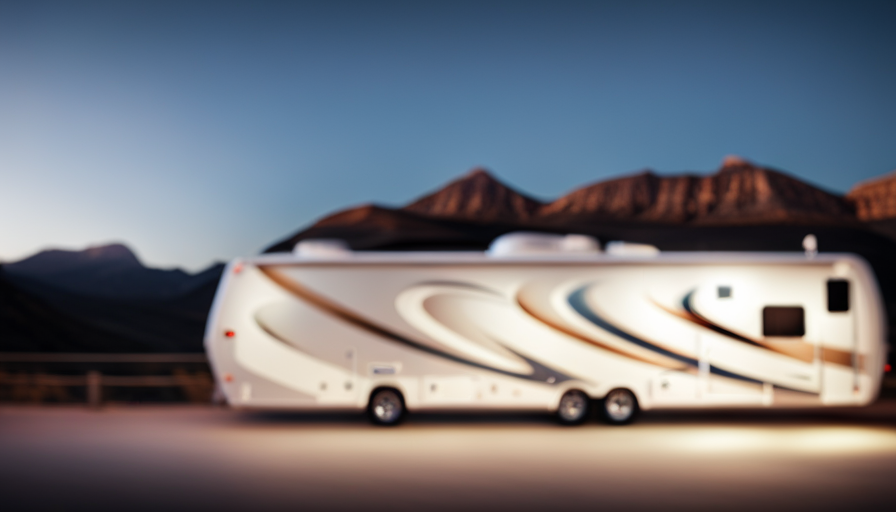Are you thinking about buying a pop-up camper but unsure about the expenses? Let me paint a picture for you. Visualize a cozy camper surrounded by the stunning beauty of the outdoors, providing a comfortable and convenient escape. Sounds enticing, right? However, before embarking on your adventure with a pop-up camper, it’s important to grasp the financial costs involved.
The cost of a pop-up camper can vary depending on a few factors. Factors such as the type of camper, the brand, the model, and even the amenities it offers can all influence the price. That’s why it’s important to do your research and set a budget before diving into the world of pop-up campers.
In this article, I will guide you through the process of understanding the different types of pop-up campers, setting a budget, researching prices, and even negotiating the price of your dream camper. We’ll also explore financing options and the pros and cons of buying a used pop-up camper.
So let’s dive in and find out how much a pop-up camper really costs!
Key Takeaways
- The cost of a pop-up camper can vary based on factors such as type, brand, model, amenities, size, materials used in construction, and luxury features.
- The average price of a new pop-up camper is around $10,000, with basic models ranging from $6,000 to $8,000, mid-range models from $8,000 to $12,000, high-end models from $12,000 to $16,000, and luxury models priced at $16,000 and above.
- Researching pop-up camper prices is important, considering both the initial cost and ongoing maintenance costs such as insurance, registration fees, storage fees, and regular maintenance.
- Additional costs to consider include maintenance expenses, insurance costs ranging from $100 to $500 per year, registration fees ranging from $20 to $100, and regular maintenance expenses ranging from $500 to $1,500 per year.
Factors that Influence the Cost of Pop-Up Campers
The price of pop-up campers can vary depending on several factors that influence their cost. Understanding different types of pop-up campers is essential when comparing prices across brands and models.
One factor that affects the cost is the size of the camper. Smaller pop-up campers generally have a lower price tag compared to larger ones.
The materials used in the construction of the camper also play a role in its cost. High-quality materials may increase the price, but they can also provide better durability and longevity.
Another factor to consider is the features and amenities included in the camper. Campers with more luxury features such as air conditioning, kitchenettes, and bathrooms tend to be more expensive.
Additionally, the brand and model of the camper can influence its price. Well-known brands or models with a higher demand may come with a higher price tag.
Understanding these factors can help you make an informed decision when purchasing a pop-up camper. Transitioning into the subsequent section about understanding different types of pop-up campers, it is important to consider all these factors in order to find the right camper that meets your needs and budget.
Understanding Different Types of Pop-Up Campers
I’ll be discussing the different types of pop-up campers: tent trailers, A-frame campers, hard-sided pop-ups, and hybrid campers.
Tent trailers are lightweight and versatile, making them a popular choice for camping enthusiasts.
A-frame campers offer a more compact and easy-to-tow option, perfect for those who prefer simplicity.
Hard-sided pop-ups provide added durability and insulation, ideal for camping in various weather conditions.
Finally, hybrid campers combine the benefits of a traditional travel trailer and a pop-up camper, providing ample space and comfort.
Tent Trailers
Imagine yourself exploring the great outdoors, with a tent trailer providing you with a cozy retreat after a long day of adventure. Did you know that these versatile campers can range in price from $5,000 to $30,000?
Here are three reasons why tent trailers are a popular choice among outdoor enthusiasts:
-
Affordable: Tent trailers offer a budget-friendly alternative to traditional RVs, making them accessible to a wide range of campers.
-
Compact and Lightweight: These campers are designed to be compact and lightweight, making them easy to tow and maneuver on various terrains.
-
Spacious and Comfortable: Despite their small size, tent trailers often feature expandable sleeping and dining areas, providing ample space for relaxation and comfort.
Now, let’s move on to the next type of pop-up camper, the a-frame campers.
A-Frame Campers
Ready for a unique camping experience? Step into the world of A-Frame campers and discover the perfect blend of convenience and comfort.
A-Frame campers are a popular choice among campers who are looking for lightweight options. These campers are designed with a hard-sided shell that can easily be folded down for transportation. They are known for their compact size and easy setup, making them ideal for both short trips and longer adventures.
A-Frame campers typically come equipped with basic amenities such as a bed, dining area, and storage space. They’re also known for their excellent insulation and durability. With their lightweight design and compact size, A-Frame campers offer the perfect solution for those who want to enjoy the great outdoors without sacrificing comfort.
Looking for something even more spacious? Check out the next section about ‘hard-sided pop-ups.’
Hard-Sided Pop-Ups
Hard-sided pop-ups offer campers a spacious and comfortable camping experience, with a surprising 80% of campers reporting a preference for this type of camper. These campers are designed with a folding mechanism that allows for easy setup and storage.
They typically come in two material options: fiberglass and aluminum. Fiberglass is known for its durability and lightweight nature, making it a popular choice among campers. Aluminum, on the other hand, is lightweight and offers better insulation. Both materials provide a sturdy and weather-resistant exterior.
Now, let’s transition to the next section about ‘hybrid campers’, which offer a combination of features from both hard-sided pop-ups and traditional travel trailers.
Hybrid Campers
You’ll be amazed at the versatility and convenience of hybrid campers, offering the best of both worlds for an unforgettable camping experience. Here are three reasons why hybrid campers are a great choice:
-
Spacious interiors: Hybrid campers provide ample living space when expanded, with slide-out beds and fold-out sections. This allows for a comfortable and roomy camping experience, even with a smaller towable unit.
-
Lightweight construction: Hybrid campers are designed with lightweight materials, making them easier to tow and more fuel-efficient. This means you can save on gas expenses and have a smoother towing experience.
-
Enhanced amenities: Hybrid campers often come equipped with modern amenities such as kitchens, bathrooms, and entertainment systems. These features add convenience and comfort to your camping trip, making it feel like a home away from home.
Now that you know the benefits of hybrid campers, let’s discuss setting a budget for your pop-up camper purchase.
Setting a Budget for Your Pop-Up Camper Purchase
When setting a budget for your pop-up camper purchase, you can’t ignore the fact that the average price of a new pop-up camper is around $10,000, which can vary depending on the brand and features. To help you set a realistic budget, it’s important to consider your priorities and research prices. Below is a table outlining the average prices of different types of pop-up campers:
| Type of Pop-Up Camper | Average Price Range |
|---|---|
| Basic Model | $6,000 – $8,000 |
| Mid-Range Model | $8,000 – $12,000 |
| High-End Model | $12,000 – $16,000 |
| Luxury Model | $16,000 and above |
By understanding the price range for each type of pop-up camper, you can evaluate your needs and preferences. If you’re on a tight budget, a basic model might be the best option for you. However, if you’re looking for more luxurious features, you may need to consider a higher-end model. Remember, these prices are averages and can vary depending on factors such as brand and location.
Researching pop-up camper prices is a crucial step in finding the right camper for you. By understanding the market and comparing prices, you can make an informed decision and find the best deal that fits your budget.
Researching Pop-Up Camper Prices
After setting a budget for your pop-up camper purchase, the next step is to research pop-up camper prices. This will help you get a better understanding of the cost range and allow you to make an informed decision.
When researching pop-up camper prices, it’s important to consider both the initial cost of purchasing the camper and the ongoing maintenance costs. Pop-up campers can vary in price depending on factors such as brand, size, features, and condition.
The initial cost of a pop-up camper can range anywhere from $3,000 to $20,000 or more. Factors that can impact the price include the age and condition of the camper, as well as any additional features or upgrades it may have.
In addition to the initial cost, it’s important to consider the ongoing maintenance costs of owning a pop-up camper. This can include expenses such as insurance, registration fees, storage fees, and regular maintenance and repairs.
By setting up a budget and researching pop-up camper prices, you can ensure that you’re making a wise financial decision.
In the next section, we’ll discuss how to compare prices across different brands and models to find the best deal.
Comparing Prices Across Brands and Models
To effectively evaluate prices across various brands and models, it’s imperative to conduct a thorough comparison. When comparing prices, it’s important to consider the features, quality, and reputation of each brand and model.
One way to compare prices is by using online resources and marketplaces that provide a wide range of options. These platforms allow you to filter and sort the listings based on price, making it easier to find the best deals.
In addition to online resources, visiting local dealerships and attending RV shows can also provide valuable insights into the pricing of pop-up campers. Talking to sales representatives and asking for price quotes from different brands and models can help you get a better idea of the average cost.
When comparing prices, keep in mind that the cheapest option may not always be the best choice. It’s important to consider the overall value, including the quality of materials, durability, and warranty. Sometimes, spending a little more upfront can save you money in the long run by avoiding costly repairs or replacements.
Considering additional costs, such as maintenance, insurance, and storage fees, is also crucial when evaluating the affordability of a pop-up camper. By comparing prices and taking into account these factors, you can make an informed decision that suits your budget and needs.
Considering Additional Costs
When considering the additional costs of owning a pop-up camper, there are a few key points to keep in mind.
Firstly, insurance and registration fees can vary depending on the state and value of the camper. It’s important to factor in these costs when budgeting for your purchase.
Secondly, maintenance and repairs should also be taken into account. Regular servicing and unexpected repairs can add up over time.
Finally, don’t forget to budget for camping gear and accessories. This includes bedding, cooking equipment, and outdoor furniture, as they are essential for a comfortable camping experience.
Insurance and Registration
Protect your investment in your pop-up camper by obtaining insurance and registration, which serve as a shield of security and peace of mind during your adventurous journeys.
Insurance costs for a pop-up camper can vary depending on factors such as the make, model, and age of the camper, as well as your personal driving record and location. On average, you can expect to pay anywhere from $100 to $500 per year for insurance coverage.
When it comes to registration, the process is relatively straightforward. You’ll need to provide proof of ownership, pay a registration fee, and obtain license plates and a registration sticker. The costs for registration will vary depending on your state, but typically range from $20 to $100.
Once you have insurance and registration in place, you can focus on enjoying your pop-up camper adventures.
Moving on to maintenance and repairs…
Maintenance and Repairs
When it comes to owning a pop-up camper, there are a few important things to consider beyond just insurance and registration. One of these factors is the cost of maintenance and repairs. While pop-up campers are generally less expensive to maintain compared to larger RVs, there are still some costs involved. Regular maintenance tasks such as checking the tires, inspecting the roof for leaks, and servicing the appliances can help prevent major repairs down the line. However, it’s important to budget for unexpected repairs as well. Common repairs for pop-up campers include fixing plumbing issues, repairing canvas tears, and addressing electrical problems. On average, maintenance costs for a pop-up camper can range from $500 to $1,500 per year, depending on the age and condition of the camper. Now, let’s move on to the next topic of camping gear and accessories.
Camping Gear and Accessories
Gear up for your camping adventures with a wide range of accessories that will enhance your outdoor experience. Here are four camping essentials that you shouldn’t leave home without:
-
Sleeping Bags: Stay cozy and comfortable during your nights under the stars with high-quality sleeping bags designed for various temperatures.
-
Camping Stove: Cook delicious meals in the great outdoors with a portable camping stove. It’s perfect for preparing everything from morning coffee to hearty dinners.
-
Portable Chairs: Relax and unwind after a long day of outdoor activities with comfortable and lightweight portable chairs. They’re easy to pack and provide a comfortable place to sit around the campfire.
-
Lanterns and Headlamps: Illuminate your campsite and navigate through the dark with lanterns and headlamps. These essential tools ensure you can continue your outdoor adventures even after the sun sets.
Now that you’re ready to go camping with all the necessary gear, let’s move on to negotiating the price of a pop-up camper.
Negotiating the Price of a Pop-Up Camper
When negotiating the price of a pop-up camper, there are a few tips that I’ve found to be effective.
First, it’s important to do your research and understand the market value of the camper you’re interested in. This will give you a better idea of what a fair price would be and help you negotiate with confidence.
Additionally, being prepared to walk away if the seller isn’t willing to negotiate can give you leverage in the negotiation process.
Tips for Effective Negotiation
Negotiating effectively can be a game-changer when it comes to getting the best price for a pop-up camper. As the saying goes, "You catch more flies with honey than with vinegar." Understanding the seller’s perspective and employing effective communication techniques are essential in achieving a successful negotiation. To help you navigate this process, consider the following table:
| Negotiation Tips | Emotion Evoked | Reasoning |
|---|---|---|
| Be respectful and polite | Trust | Building a positive relationship with the seller can lead to better deals. |
| Research market prices | Confidence | Knowing the market value gives you leverage during negotiations. |
| Offer a win-win solution | Cooperation | Showing flexibility and willingness to compromise can lead to a mutually beneficial outcome. |
By understanding market value and utilizing these negotiation strategies, you can increase your chances of securing a great deal on a pop-up camper.
Understanding Market Value
To get the best deal on a pop-up camper, it’s crucial for you to understand the market value and how it can work in your favor. Here are some factors affecting resale value and the cost of upgrades and customization that you should consider:
- Age and condition: Older campers, or those in poor condition, typically have a lower market value.
- Brand reputation: Well-known brands often hold their value better than lesser-known ones.
- Features and amenities: Campers with popular features, such as air conditioning or a bathroom, tend to have a higher market value.
When it comes to upgrades and customization, keep in mind that these can add significant costs to the overall price. While they may enhance your camping experience, they may not necessarily increase the resale value in proportion to the amount spent.
Understanding market value and the impact of upgrades will help you make informed decisions when negotiating for the best price.
Now, let’s explore financing options for purchasing a pop-up camper.
Financing Options for Purchasing a Pop-Up Camper
If you’re looking to buy a pop-up camper, there are various financing options available that can make owning one more affordable and accessible for you. When it comes to financing, it’s important to consider the loan terms that best fit your financial situation. Here are some common financing options for purchasing a pop-up camper:
| Financing Option | Loan Terms |
|---|---|
| Dealer Financing | This option allows you to finance your pop-up camper directly through the dealership. They often offer competitive interest rates and flexible payment plans. |
| Bank Loan | You can also secure a loan from a bank or credit union. This option usually requires a down payment and offers fixed interest rates. |
| Personal Loan | If you have a good credit score, you may qualify for a personal loan. This type of loan can be used for any purpose, including purchasing a pop-up camper. |
| Peer-to-Peer Lending | Another option is peer-to-peer lending platforms, where individuals can borrow money from other individuals. These platforms often offer competitive interest rates and flexible terms. |
Exploring these financing options can help you find the best fit for your budget and lifestyle. After considering your financing options, you can move on to the next step of buying a used pop-up camper.
Buying a Used Pop-Up Camper
When buying a used pop-up camper, it’s crucial to thoroughly inspect for wear and tear. This includes checking for any signs of water damage. Additionally, it’s important to examine the condition of the canvas and zippers. Another aspect to inspect is the tires and suspension. By being diligent in this inspection process, potential buyers can avoid common pitfalls such as purchasing a camper with hidden issues or needing costly repairs.
Inspecting for Wear and Tear
First, take a moment to imagine yourself stepping inside a pop-up camper and noticing any signs of wear and tear. To ensure you make a wise purchase, it is crucial to conduct a thorough inspection using a wear and tear inspection checklist. Look for any indications of water damage, such as stains, discoloration, or a musty smell. Additionally, check for any tears, holes, or fraying in the canvas, as this can compromise the camper’s integrity. Pay attention to the condition of the flooring, furniture, and appliances, ensuring they are in good working order. To help you remember what to look for, refer to the table below:
| Signs of Wear and Tear | Indications of Water Damage | Canvas Condition | Flooring | Furniture and Appliances |
|---|---|---|---|---|
By thoroughly inspecting for wear and tear, you can avoid common pitfalls when buying a used pop-up camper. Transitioning into the next section, let’s explore some tips for avoiding these pitfalls.
Avoiding Common Pitfalls
To ensure a successful purchase, it’s crucial to steer clear of common pitfalls when buying a used pop-up camper. When searching for a pop-up camper, it’s important to be aware of potential scams and avoid unreliable sellers. Here are five tips to help you avoid these pitfalls:
-
Research the seller: Before making any commitments, thoroughly research the seller. Look for reviews or ratings from previous buyers to ensure their reliability.
-
Inspect the camper in person: Don’t solely rely on online pictures or descriptions. Inspect the camper in person to check for any hidden issues or damages.
-
Ask for maintenance records: Request the maintenance records to get an idea of how well the camper has been taken care of.
-
Verify ownership and title: Make sure to verify the ownership and title of the camper to avoid any legal issues down the line.
-
Trust your instincts: If something feels off or too good to be true, trust your instincts and keep looking.
By avoiding scams and finding reliable sellers, you can make a confident decision and start enjoying your pop-up camper adventure.
Making the Final Decision and Enjoying Your Pop-Up Camper Adventure
Embark on your pop-up camper adventure, reveling in the final decision and relishing the ride. Now that you’ve made the decision to purchase a pop-up camper, it’s time to start planning your first trip.
The first thing you need to do is learn how to set up your pop-up camper. This can be a bit tricky at first, but with practice, it becomes easier. Luckily, there are plenty of online tutorials and videos that can guide you through the process step by step.
Once you’ve mastered the art of setting up your pop-up camper, it’s time to find the perfect campsite. There are numerous websites and apps that can help you find campsites specifically for pop-up campers. These resources provide information on amenities, availability, and even user reviews. It’s important to consider factors such as location, proximity to attractions or activities, and the availability of hookups or amenities that you may need.
By taking the time to learn how to set up your pop-up camper and finding the ideal campsite, you can ensure a smooth and enjoyable experience on your pop-up camper adventure. So, pack your bags, hit the road, and embrace the freedom and flexibility that comes with owning a pop-up camper. Happy camping!
Frequently Asked Questions
What are some common additional costs associated with owning a pop-up camper?
Some common additional costs associated with owning a pop-up camper include insurance requirements and additional maintenance costs. Insurance is necessary to protect your investment and cover potential damages or accidents. The cost of insurance will vary depending on factors such as the value of the camper and your location.
In terms of maintenance, you may need to budget for regular servicing, repairs, and replacements of parts. These costs can vary depending on the age and condition of the camper.
Can I negotiate the price of a pop-up camper with the seller?
Negotiating the price of a pop-up camper with the seller requires finesse. To succeed, I recommend employing some allegorical techniques.
Put yourself in the seller’s shoes, understanding their perspective. Start by building rapport and showing genuine interest.
Then, highlight any flaws or potential repairs needed. Emphasize comparable prices in the market to support your offer.
Lastly, be prepared to compromise and find a mutually beneficial agreement. These negotiating tips will increase your chances of securing a favorable deal.
What financing options are available for purchasing a pop-up camper?
When it comes to financing options for purchasing a pop-up camper, there are several choices available. Many dealerships offer in-house financing or can assist in finding a loan through a third-party lender.
Additionally, you can explore options such as personal loans or RV loans from banks or credit unions. It’s important to compare interest rates and terms to find the best loan option for your needs.
What are some factors to consider when buying a used pop-up camper?
When buying a used pop-up camper, there are a few things to keep in mind. First, inspect the camper thoroughly for any signs of damage or wear. Look for leaks, rust, or structural issues.
Additionally, check the appliances, plumbing, and electrical systems to ensure they’re in working order.
To estimate the value of a used pop-up camper, consider factors such as age, condition, and brand reputation. It’s always a good idea to get a professional inspection done before making a purchase.
How can I ensure that I am making the right decision when purchasing a pop-up camper?
When purchasing a pop-up camper, there are several tips to ensure you’re making the right decision.
Firstly, thoroughly inspect the camper for any signs of damage or wear. Check the roof, canvas, and interior for any leaks or tears.
Secondly, test all the appliances and systems to make sure they’re in working order.
Lastly, research the brand and model to determine its reputation for quality and reliability.
These tips will help you make an informed decision when buying a pop-up camper.
What is the Average Cost of a Pop Up Camper?
The pop up camper price guide is a helpful tool for individuals looking to invest in a pop up camper. On average, the cost of a pop up camper can range from $6,000 to $20,000, depending on various factors such as brand, size, and additional features. It is always a good idea to consult the pop up camper price guide to get a better understanding of the price range and make an informed decision.
Conclusion
After researching and comparing prices, it’s evident that the cost of a pop-up camper can vary significantly depending on factors such as brand, model, and features.
By setting a budget and negotiating the price, it’s possible to find a camper that suits your needs and fits within your financial means.
Whether purchasing a new or used camper, it’s important to carefully consider all options and make an informed decision.
With proper planning and financing, you can embark on an exciting adventure with your pop-up camper.











